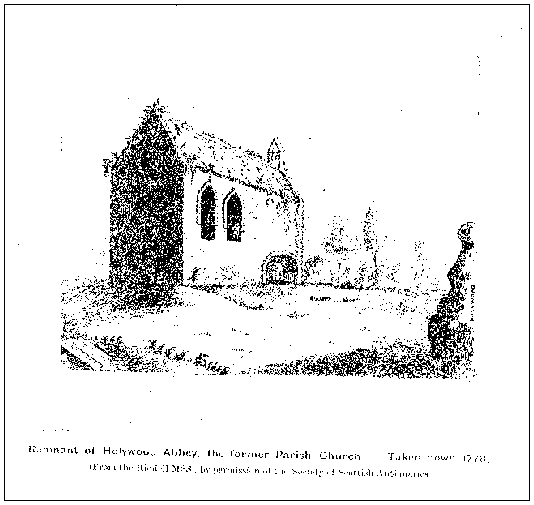Holywood Abbey
The date of foundation of the Abbey is not known precisely, but probably dates from circa 1180. The Premonstratensian order had begun in 1121 in the diocese of Laon, France; other abbeys of the order were being built around Britain in the twelfth century. The Premonstratensian order was a mixture of the monastic and canonical, following chiefly the rule of St Augustine. The order was also sometimes called candidus ordo, because their garb was entirely white.
Before the Abbey foundation, the site appears to have been the cell of a monk named Congall; Dercongall, one of the early names to the site, means 'the oak wood of Congall'. The abbey was consequently sometimes referred to as Dercongal Abbey. The site was also referred to in Papal Bulls as St. Bois, Sacro Bosco, Nemus Sacrum, and Monasterium sacris nemoris ("monastery of the sacred grove").
Figure of an eccesiastic (identified as St Norbert) found in the neighbourhood of the Abbey site.
From 'Revirosco', p. 32.

Seal of Holywood Abbey, exhibiting 'in the centre a dove sitting on an acorn of a tree; in the lower part, two estoiles (stars with wavy rays). The legend is:-- "S coe Abbis et Conventi Sac Nemoris" (Common seal of the Abbey and Convent of Holywood)



Left: 'an arm issuing from a cloud, its right hand grasping a crozier in front of a flourishing tree, with the legend:-- "S.Abbatis Sacri Nemoris" (Seal of the Abbot of Holywood).
Right: 'a monk standing on a bracket between a star and a crescent, with pastoral staff in his left hand, holding a bush in flourish in his right. The legend is:-- "S. Abbatis de Sacro Nemore" (Seal of the Abbot of Holywood).
Seals, and their descriptions, from 'Revirosco', p. 33.
The Abbey itself was Early English and cruciform in shape with an oak roof and a Norman arch (the portion remaining in the 18th century, shown below from a contemporary engraving, was said to be part of the head of the cross). According to Francis Grole (Antiquities of Scotland, 1789), "cross the middle of the building was a fine Gothic arch that supported the oak roof. Under the floor were a number of sepulchral vaults. The entrance was through a handsome semicircular arch". A similar chancel, still surviving, is found at Whithorn, which founded a Premonstratensian institution at about the same time.

From de Cardonell, Picturesque Antiquities of Scotland. The remaining portion of the abbey was dismantled in 1778; its stones were used to construct a new church.
1849 sketch (i.e. 70 yrs after dismantlement) by John McCormick based on written sources and the above illustration. Unpublished sketchbook, reproduced by courtesy of the Dumfries Museum

Inscription on one of the two surviving Abbey bells, still in situ and used as the parish church bell until the early 2000s. From 'Revirosco', p.30.

1811 sketch by antiquarian George Henry Hutton of a 7x2 ft stone from the west door of Holywood Abbey, 'at the south east corner of the church ground where part of the abbey is said to have stood'. [SCRAN (c) National Library of Scotland; copying for educational use only].
